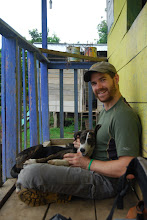
The sun shines brightly through the broken canopy, yet the rain that fell several days ago can still be felt in the soil. Acorns and beechnut husks press into my feet as I walk up the hillside through thickening briars. Crossing over a neighbor’s four-wheeler path, I stop to momentarily peruse his growing pile of refuse – a few old tires, rusting barrels full of ash, old rain gutters, and rotting plywood. I wish this were an uncommon sight, yet these personal dumps are just as much a part of these woods as the trees that make them.

I continue up the hillside past an old treestand into an area dense with shrubs and briars. Someone cut the trees here while I was still in high school, and promptly set up a hunting spot in the clearing. Surprisingly, the deer trail here didn’t dissolve into the thickening brush over the years. The deer appear to bed in the dense brush in this sheltered area of the mountain, where they are still less than 100 yards from a healthy crop of acorns atop the slope, and only 100 yards from a verdant field below. While I have come to prefer the darker, wetter areas of forest, I see how this is the perfect location for these deer.

Sneaking my way through the briars, I still make a ridiculous amount of noise. I only make it about three steps into the thicket before several deer blast from the other side and dissolve back into the distant silence of the forest just as quickly. Trudging on through the thicket, I follow the well-worn path up to the large oaks above.
A few bright pink acorns riddled with bite marks are splayed open on the forest floor. I wrinkle my nose just thinking of the bitter taste squirrels must endure, or perhaps even relish. I boiled a bowl of acorns with a friend in college once for six hours, and they still tasted like stomach bile. Amidst the destroyed acorns, I find a small seedling gaining purchase on the trail a few feet later, and wonder if it will make it.

It will most likely be nipped at the bud in short order, but with any luck it will be enough time for it to sink a taproot deep enough into the soil to procure adequate moisture to make it through to next year, when it will sprout again, most likely providing fodder for another passing deer. Many hardwood seedlings will live this seemingly menial existence for decades, just garnering enough energy to sink their roots deeper until finally one of their relatives towering above is brought down. Thousands of seedlings begin an immediate race that will last many seasons, even much longer than my life, until the gap is finally closed in again. To me, an oak seedling is something very special. It is a solemn reminder of the strength that exists in everything. Be it two inches or two hundred feet high, I see oak as the backbone of this forest, providing a few leaves each year for a passing deer, or a healthy crop of acorns in its old age. It is a reminder of the natural virtue that exists in all life.
I step out of the forest onto a jeep trail, scanning some deer prints as I pass. I follow the deer trail back into the woods, down over the other side of the ridge, and past an old hunting spot, now tangled with logging slash. Just past our old hunting spot, the forest composition shifts in accord with the soil. An old spring bed over time has been eroded into a stream of large rocks, covered in moss. Small saplings poke out of the rocks like bristles on a brush, while some larger trees skirt the edge where some soil still exists.
A few hundred feet later, the hill flattens out, and the spring returns to the surface. This area is the hidden eden of the Bald Hills. Old trees cling to shallow clay soils soaked in spring vigor. Mayapple has begun sprout amongst the wild periwinkle.

As I scan the understory I can’t help but imagine a hen turkey lying hidden upon eggs somewhere within those verdant stalks. A few years ago during a summer research project I walked within three feet of a hen on 12 eggs without seeing her. She exploded from the late April cover when I was only several feet past her. I jumped and covered my head, thinking I was about to be attacked. Her eggs were mealy brown with reddish brown speckles. A week later we found ten poults hiding in a bush close to the empty nest.
I walk slowly along trickling spring, scanning hopefully for a motionless hen, and I find myself walking along a deer trail again as I come upon a crossing. I scan countless dents in the soil indicating deer still use this crossing regularly, but then I see a different print across the spring pressed into the thick clay. It is an old canine print, most likely a coyote. They have become rather rampant in Pennsylvania, and have even begun to display packing behavior to bring down adult deer. That is the only print I can find, so I move on.

I slosh on along the path until my feet finally tell me they have had enough cold mud, and I turn away from the spring towards the surrounding hills. Where the slopes meet the flatter hollow bottom, a different forest lies hidden. This lucky section of forest is a little too wet too log, yet remains on just enough of a slope to keep from drowning. Older oaks, poplars, and maples are swelling above me, their buds only days away from bursting. In a week or less this bright forest floor will be cast in darkness for several months. A few hemlocks hide here, speckling the forest in a deep, lacey green. Towering hemlocks, several hundred years old once covered these hollows. These hemlocks are now a juvenile image of what they could become in the distance future, but they will most likely never reach such a potential. Tiny white dots speckle these branches upon closer inspection. I reach up, brushing my hand along a branch, and watch it wave back at me for several seconds. This hemlock is perhaps a foot wide at its base, between sixty to eighty years old, and it is as good as dead.

The tiny white dots at the base of each deep green needle are the tell-tale sign of the wooly adelgid, a small, xylophagous (sap-sucking) insect larvae. Generations of these larvae will slowly suck the life out of this tree year after year, until finally it is too weak to combat the challenging environment. Foresters worry the hemlock will succumb to the same fate out chestnuts did some time ago.









